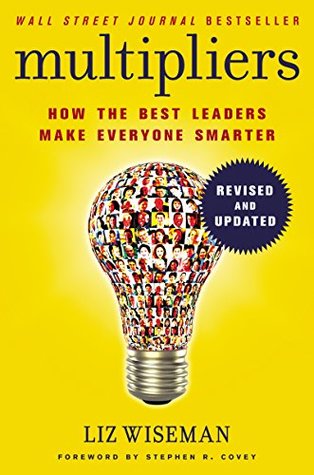More on this book
Community
Kindle Notes & Highlights
Regardless of the venue, visualize the point in the conversation when you symbolically
give the pen back.
Here are some statements that signal that you are handing back the pen: I’m happy to help think this through, but I’m still looking to you to lead this going forward. You are still the lead on this. I’m here to back you up. What do you need from me as you lead this?
1. Give 51 percent of the vote 2. Let nature take its course 3. Ask for the F-I-X 4. Give it back Leveraging Resources
Multipliers do get involved in the operational details, but they keep the ownership with other people. 2. Multipliers are rated 42 percent higher at delivering world-class results than their Diminisher counterparts.
We judge others by their doings, but ourselves by our intentions. EDWARD WIGGLESWORTH
They assume that their energy is contagious, like a virus to be caught by anyone in their presence.
Energy isn’t contagious, but attitude and confidence in others are.
When the leader is always on, everyone else is always off.
Yes, there are times when employees appear to appreciate the help, yet the behavior is nonetheless diminishing—while they may feel relief, they haven’t grown or even fully utilized the intelligence they have.
As leaders, sometimes we are most helpful when we don’t help.
She takes the lead, sets the pace, and expects that the people around her will notice, follow, and, of course, catch
He wasn’t opposed to the idea that it was doable; he simply wanted me to acknowledge the challenge and recognize his struggle.
He didn’t want me glossing over the challenge with my optimism.
When you play the role of the optimist, you undervalue the struggle the team is experiencing and the hard-fought learning and work.
When the leader sees only the upside, others can become preoccupied with the downside.
This leadership team understood that self-awareness as a leader comes from understanding the perspectives of those we lead and serve, those who are the “customers” of our leadership. Our learning can start with our own insight, but it can’t end there.
How might I be shutting down the ideas and actions of others, despite having the best of intentions? What am I inadvertently doing that might be having a diminishing impact on others? How might my intentions be interpreted differently by others? What messages might my actions actually be conveying? What could I do differently?
“I can’t control the ideas that pop into my head, but I can control
ones that come out of my mouth.”
Becoming a Multiplier often starts with becoming less of a Diminisher. And this usually means doing less: less talking, less responding, less convincing, and less rescuing of others who need to struggle and learn for themselves. By doing less, we can become more of a Multiplier.
Doing less to achieve more is one of many examples where counterintuition is more instructive than intuition.
Seek feedback • Lead with intention • Practice the workarounds and learning experiments found in appendix E, “Multiplier Experiments” • Do less and challenge more
However vast the darkness, we must supply our own light. STANLEY KUBRICK
the most popular strategies for dealing with Diminishers are also the least effective.
The best way out of a diminishing death spiral is through multiplication—using the logic of multiplication and leading like a Multiplier yourself.
It’s not necessarily about you, Diminishing isn’t inevitable, and You can lead your leader
if you can’t get inside the Diminisher’s trust circle, build other circles of influence.
While some people like to argue more than others, everyone likes to hear that someone is seriously considering their opinions. When you retreat and regroup, you give the Diminisher a way out as well—an
opportunity to gracefully rethink an issue and to save face.
Our recent research showed that there is a greater risk of extreme diminishing when the two individuals have dissimilar personality types or processing styles.
The next time someone gives you a statement of work, ask to begin with a problem definition instead.
The second type of critical information
is performance feedback: Am I actually hitt...
This highlight has been truncated due to consecutive passage length restrictions.
The term feedback often carries the connotation of criticism or judgment; however, technically speaking, feedback is simply information to help recalibrate something.
Likewise, you can give someone a user’s manual to you. What are you good at? What do you do naturally, without much effort, and what do you do freely, without being coerced or incentivized?
Instead of going into battle, look for common ground.
he makes sure the person knows he is genuinely listening. He faces them and asks, “Do you mind if I take some notes? I like to go back and think about what you said.” He then summarizes what he’s heard and looks for mutual agreement. In the process, the other person becomes less of a Diminisher and more of a partner.
When you transmit what you learned, you
earn the space you need to get it right the next time. Instead of a Micromanager,
your boss becomes more of an Inv...
This highlight has been truncated due to consecutive passage length restrictions.
giving you ownership and the accountability th...
This highlight has been truncated due to consecutive passage length restrictions.
A boss sharing his or her own mistakes! That could liberate an entire team and create a culture where experimentation and innovative risk taking are legitimized.
people are smart and can learn from their mistakes and figure it
out.
The rest of us grow and learn by doing something hard, something we haven’t done before, something we don’t yet know how to
do.


